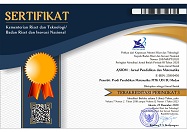Zone of teacher promoted action based on gender in math lesson
Abstract
This study was conducted to understand the Zone of Promoted Action (ZPA) of teachers in the context of mathematics learning, based on gender. This research is a descriptive exploratory study using a qualitative approach. The data analysis techniques employed in this study include data transcription, data checking, data reduction, data credibility, and conclusion drawing. The subjects of this study are pre-service PPG students who are prospective teachers. The instruments used in this study include questionnaires and observation sheets. Based on the results of the study, it can be concluded that each teacher, regardless of gender background, possesses unique ZPA capabilities characterized by their ability to manage time, guide discussions, and focus students on the material.
Keywords
Full Text:
PDFReferences
Al Baqi, S. (2023). How teacher’s gender influence student’s gender identity in early childhood. JPUD - Jurnal Pendidikan Usia Dini, 17(1), 108–119. https://doi.org/10.21009/jpud.171.08
American Psychological Association. (2013). 2012 Annual report of the American Psychological Association. In The American psychologist (Vol. 68, Issue 5). https://doi.org/10.1037/h0094960
Blanton, M. L., Westbrook, S., & Carter, G. (2005). Using valsiner’s zone theory to interpret teaching practices in mathematics and science classrooms. Journal of Mathematics Teacher Education, 8, 5–33. https://doi.org/10.1007/s10857-005-0456-1
Budi, M., Ali, M. S., & Nasrullah. (2023). Pengaruh perbedaan jenis kelamin guru terhadap minat belajar siswa pada mata pelajaran pendidikan agama islam. Al-Furqan: Jurnal Agama, Sosial Dan Budaya, 2(4), 132–145. https://publisherqu.com/index.php/Al-Furqan/article/view/487
Danoebroto, S. wulandari. (2015). Teori belajar konstruktivis piaget dan vygotsky. Indonesian Digital Journal of Mathematics and Education, 2(3), 191–198. http://idealmathedu.p4tkmatematika.orgissn2407-7925
Faizah, S., Nusantara, T., Sudirman, Rahardi, R., Susiswo, Subanji, & Agustina, R. K. (2022). Teachers’ communication in mathematics learning based on zone of promote action. AIP Conference Proceedings, 2633(1), 1–7. https://doi.org/10.1063/5.0102613
Goos, M. (2005). A sociocultural analysis of learning to teach. Proceedings of the 29th Conference of the International Group for the Pscyhology of Mathematics Education, 3(June), 49–56.
Iffah, J. D. N., Sutawidjaja, A., Sadijah, C., & Subanji. (2016). Teacher ’ s Rejected Promote Action ( R -PA ) for Mathematics Teaching Practice in Class. IOSR: Journal of Research & Method in Education, 6(5), 12–18. https://doi.org/10.9790/7388-0605031218
Iffah, J. D. N., & Tristanti, L. B. (2022). Describing prospective teacher’s promote action in online mathematics learning. JRAMathEdu (Journal of Research and Advances in Mathematics Education), 7(3), 161–177. https://doi.org/10.23917/jramathedu.v7i3.17258
Isak, G., & Posch, P. (2013). Variation theory and the improvement of teaching and learning. International Journal for Lesson and Learning Studies, 2(2), 188–194. https://doi.org/10.1108/20468251311323414
Jauhara, D. N. I., Akbar, S., Cholis, S., & Subanji. (2017). Using valsiners zone theory for identifying the forms of students pseudo responses in mathematics teaching process. Educational Research and Reviews, 12(15), 744–753. https://doi.org/10.5897/err2016.3098
Lamb, C., W, Hair, J., F, M., Octarevia, C., & David. (2011). Pemasaran buku 1. Salemba Empat.
Pulungan, N. A. (2019). Kelamin Guru Dengan Prestasi Belajar Biologi Siswa Di Sma Negeri 2 Padangsidimpuan. Journal Education and Development, 7(1), 84–90. https://doi.org/10.37081/ed.v7i1.782
Rachman, M., & Tjalla, A. (2008). Keterampilan pengelolaan kelas dilihat dari jenis kelamin dan kecerdasan emosi guru sekolah luar biasa. Jurnal Ilmiah Psikologi Gunadarma, 2(1), 1–7. http://www.ejournal.gunadarma.ac.id/index.php/psiko/article/view/238%0Ahttp://www.ejournal.gunadarma.ac.id/index.php/psiko/article/viewFile/238/179
Retnawati, H., Munadi, S., Arlinwibowo, J., Wulandari, N. F., & Sulistyaningsih, E. (2017). Teachers’difficulties in implementing thematic teaching and learning in elementary schools teachers ’ diffi culties in implementing thematic teaching. The New Educational Review, 48(2), 201–212. https://doi.org/10.15804/tner.2017.48.2.16
Suardipa, I. P. (2020). Proses scaffolding pada zone of proximal development (zpd) dalam pembelajaran. Widyacarya, 4(1), 79–92. https://doi.org/10.55115/widyacarya.v4i1.555
Suhaibah, Syafruddin, R., & Washfiah, K. (2022). Pengaruh perbedaan jenis kelamin guru terhadap minat belajar siswa. The 4th Annual Postgraduate Conference on Muslim Society, 27–34.
Sum, T. A., & Talu, A. T. I. (2019). Faktor penyebab kurangnya minat laki-laki untuk menjadi guru paud di kabupaten manggarai. Jurnal Pendidikan Dan Kebudayaan Missio, 10(2), 192–203. https://doi.org/10.36928/jpkm.v10i2.170
Syamsuddin, S., & Utami, M. A. P. (2023). Perspektif guru pada dimensi pengukuran dan penilaian dalam pembelajaran matematika. AXIOM : Jurnal Pendidikan Dan Matematika, 12(1), 1. https://doi.org/10.30821/axiom.v12i1.9263
Valsiner, J. (1997). Culture and the development of children’s action: a theory of human development. John Wiley & Sons Inc.
VandenBos, G. R. (2007). Apa dictionary of psychology. American Psychological Association.
Werdiningsih, W., & Natsir, A. (2020). Gender equality and equity with mubadalah concept and its implementation in islamic education. Addin, 14(2), 305–328. https://doi.org/10.21043/addin.v14i2.7179
DOI: http://dx.doi.org/10.30821/axiom.v13i2.20104
Refbacks
- There are currently no refbacks.
Copyright (c) 2024 Nadrah Afiati Nasution, Nurhasanah Siregar, Imelda Wardani Br. Rambe, Erminawaty Simanjuntak

This work is licensed under a Creative Commons Attribution-ShareAlike 4.0 International License.
p-ISSN: 2087-8249 | e-ISSN: 2580-0450
Indexed by:
AXIOM : Jurnal Pendidikan dan Matematika is licensed under a Creative Commons Attribution-ShareAlike 4.0 International License.











